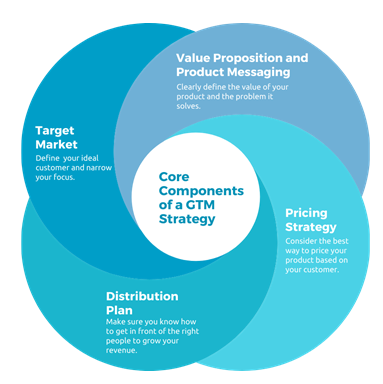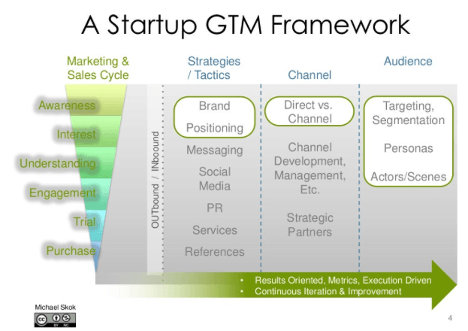A go to market strategy (or GTM strategy) is a detailed roadmap for the launch of either a new product to an existing market, or an existing product to a new market.
In both scenarios, all businesses face a similar challenge – how to get the product in front of potential customers.
A go to market strategy aims to remove the guesswork when it comes to overcoming this challenge, providing the organisation with a clear course of action for developing a marketing plan, pricing strategy, sales strategy, and distribution model and distribution model to gain a competitive advantage.

(Image source: incisive-edge.com)
Read more: What Is A Go To Market Strategy?
What’s a Go To Market Strategy Framework?
A GTM strategy framework is a written document, spreadsheet, checklist, Kanban board, or other record that organisations follow when bringing a product to market, ensuring the product market fit is accurate. The precise elements of the framework vary from company to company, product to product, and market to market – but it generally consists of a comprehensive business plan detailing the target audience, marketing strategy, and sales strategy.
Every product and every market presents unique challenges and opportunities – so it's crucial that your go to market strategy is mapped out in as much detail as possible, including common sales strategies.
A GTM strategy framework will help you do precisely that.
What Should You Include in Your Go To Market Strategy Framework?
While every go to market framework is different, they all need to capture relevant information pertaining to your target buyers, value proposition, and sales funnel.
Broadly, a GTM framework should aim to answer the following questions:
- What Are Your Buyer Personas?
- What Is Your Value Matrix?
- What Is Your Pricing Strategy?
- What Does Your Buyer’s Journey Look Like?
- What Is Your Sales Strategy?
- What Are Your Success Metrics?
Answering these questions will create a solid framework for your go to market strategy – one that will keep your resources optimised, your teams aligned, and your sales and marketing efforts in sync as you go to launch.
Go To Market Strategy Framework Example
Let’s take a look at an example go to market strategy framework.
The following startup GTM framework was created by Michael J Skok for the Harvard Innovation Lab.

(Image source: slideshare.net)
Though aimed at startups, it is a framework that can be utilised by many types of businesses preparing a product launch.
We can see down the left-hand side of the framework the familiar sales and marketing funnel that describes the various stages a prospective customer goes through on the path to purchase. First, a customer becomes aware of the product, then gains an interest in it, followed by an understanding of the value the product offers. Towards the bottom of the funnel, the marketing and/or sales team engages the potential buyer, convincing him/her to sign up to a trial, before the customer finally makes a purchase.
The rest of the framework maps the various tasks the business must complete in order to ensure a smooth funnel that nurtures as many prospects as possible from the awareness stage to the purchase stage as part of the go to market strategies.
These tasks include developing strategies and tactics – brand positioning, product messaging, social media marketing, etc. – deciding on the most appropriate sales channel, and defining the target audience.
Discover more: How to Build a Foolproof Go To Market Strategy Checklist
How to Use a GTM Strategy Framework
By its very nature, a GTM framework itself is a bare bones structure – a skeleton that needs fleshing out.
In essence, the framework is a set of questions that need answering, with those answers producing a list of actions that need to be taken.
While Skok’s visualised framework above captures the essential elements of a GTM strategy, a properly documented go to market plan will in fact be a much lengthier catalogue. Smartsheet, for example, provides the following document, serving as a much more comprehensive framework on which your fully-fleshed go to market strategy will hang.

(Image source: smartsheet.com)
In completing such a document, you will establish the following:
- A clear definition of your target market – including demographic, geographic and psychographic information
- Your value proposition and product messaging – what makes you different from your competitors? What pain points does your product solve? What, ultimately, is the value you promise to deliver to your customers after purchase? This is your value proposition
- Your pricing strategy – be it subscription-based, demand-based, tiered pricing, a freemium model, or simply a one-off price, you need a well-researched pricing strategy that maximises revenues and profits
- Your distribution plan – no matter if your product is physical or digital, you need an action plan for how it gets into the hands of your customers, be it through direct distribution (no middlemen), indirect distribution (sold via third parties), or hybrid distribution (combination of direct and indirect)
- A clear marketing strategy – all your plans for moving prosects down the sales and marketing funnel, including content marketing, lead generation and lead nurturing
- A clear sales strategy – all your plans for empowering the sales team to close as many deals as possible, including the creation of support materials that ensure your team is knowledgeable and confident enough to sell the product
- Measurements of success – a clearly defined list of key performance indicators (KPIs) that will help you benchmark and measure success, including recurring revenue (weekly/monthly/ annually), net profits, gross profits, customer acquisition costs, and customer lifetime value (CLV)
Optimise Your Go To Market Strategy Framework with Incisive Edge
95% of new products fail – don’t let yours be one of them.
A solid GTM strategy is more important today than ever before. If you need help developing and using a GTM strategy framework, book a free growth session today with the GTM experts here at Incisive Edge.








